
SPALDING STUDIES LIBRARY -- SPECIAL COLLECTIONS
Sp. Coll. Index | Mormon Classics | Oliver's Bookshelf | Newspapers | History Vault
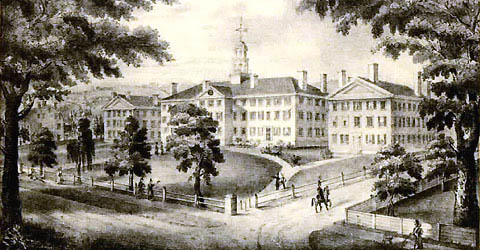

Excerpts from Chapman's 1867 Sketches of Alumni | On-line text of Sketches of Alumni
Josiah Spalding letter 1855 | "Forgotten Dartmouth Men" 1943 | Course of Instruction c. 1800
Home Missionary 1828-31 | Ethan S. Smith letter 1887 | David Persuitte book 1985/2000
Richard K. Behrens paper 2007 | R. Dawbarn & M. Miller paper 2008
|
McClure & Parish Memoirs of Wheelock (Newburyport, 1811) |
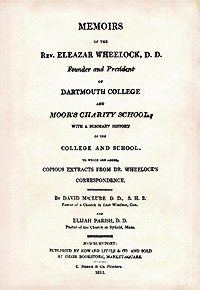
|
|
MEMOIRS OF THE REV. ELEAZAR WHEELOCK, D. D. Founder and President OF DARTMOUTH COLLEGE AND MOOR'S CHARITY SCHOOL; WITH A SUMMARY HISTORY OF THE COLLEGE AND SCHOOL. TO WHICH ARE ADDED, COPIOUS EXTRACTS FROM DR. WHEELOCK'S CORRESPONDENCE. BY DAVID M'CLURE, D. D., S. H. S. Pastor of a Church in East Windsor, Con. AND ELIJAH PARISH, D. D. Pastor of a Church in Byfield, Mass. NEWBURYPORT: PUBLISHED BY EDWARD LITTLE & CO. AND SOLD AT THEIR BOIOKSTORE, MARKET-SQUARE. C. NORRIS & CO. PRINTERS. 1811 |
|
George T. Chapman (1786-1872) Sketches of the Alumni... (Cambridge, MA: 1867) |
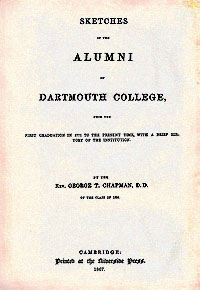
|
Dartmouth graduating class of 1785, (from an old newspaper article)
|
SKETCHES OF THE ALUMNI OF DARTMOUTH COLLEGE. FROM THE FIRST GRADUATION TO THE PRESENT TIME, WITH A BRIEF HISTORY OF THE INSTITUTION. BY THE REV. GEORGE T. CHAPMAN, D. D. OF THE CLASS OF 1804 CAMBRIDGE: Printed at the Riverside Press. 1867. |
|
[ 7 ]
ELEAZAR WHEELOCK, A. M., D. D. the son of Dea. Ralph and Ruth (Huntington) Wheelock, was born at Windham, Ct., April 22, 1711, and died at Hanover, April 24, 1779, AE. 68, minus nine days, as his birth was according to Old Style. He graduated at Yale College in 1733; studied divinity and was ordained pastor of the 2d Cong. Church in that part of Lebanon called Lebanon Creek, now Columbia, Ct, in March 1735. Here his pastorate continued for about thirty-five years, and in 1754 an Indian Charity School was established by him and named after Mr. Joshua Moor of Mansfield, Ct, one of its principal American benefactors. After its existence for sixteen years, devoted to the civilization and education of Indian youth, Dr. Wheelock, whose honorary degree was conferred by the University of Edinburgh, Scotland, June 29, 1767, determined on obtaining a more suitable location for it, and adding thereto a seminary of learning wherein they and English pupils should be trained up in classical, philosophical, and all literary, pursuits. 8 BRIEF HISTORY OF DARTMOUTH COLLEGE. such a purpose was never made. It was in the midst of A wilderness, and upon a plain where a few of its pine-trees of majestick height had been recently felled, and two or three log huts constituted the only shelter. But Dr. Wheelock was the very man to contend with difficulties, and in the spirit of an enlarged philanthropy to overcome them. The huts were multiplied; a frame house for himself, a College for the students, eight,, feet long and two stories high, a Commons' Hall or Refectory, were speedily constructed under his personal supervision. Nothing, however, was in sufficient forwardness to protect them entirely from the piercing storms of winter. Upwards of four months the snow, shielded from the rays of the sun by the evergreen forest, was four feet in depth. Severe hardships ensued, and throughout the inclement season indefatigable courage and fortitude were requisite in order to maintain the infant seminary. BRIEF HISTORY OF DARTMOUTH COLLEGE. 9 1802, became President. But the old Trustees refused to acquiesce in this proceeding, insomuch that the two institutions were carried on at the same time in [antagonism] each other. Resort was then had to a legal tribunal. In the [first instance], the case came before the State Supreme Court, by which the [legality] was sustained and the University pronounced the only valid corporation. From this decision the College Trustees appealed to the Supreme Court of the United States, of which the profound jurist, John Marshall, LL. [was] Chief Justice. After a long argument by eminent counsel on both sides, Daniel Webster, D. C. 1801, being one of the advocates for his Alma Mater, the judgment of the inferior court was reversed and old Dartmouth restored to its former position, much to the satisfaction of the country, by reason of the maintenance of eleemosynary and vested corporate rights. 36 ALUMNI 1785.
ALUMNI 1785. 37 TIMOTHY DICKINSON, A. M. the son of Nathan and Esther (Fowler) Dickinson, was born at Amherst, Ms, June 25, 1761, and died at Holliston, Ms, July 6, 1813, AE. 52. He was in the Rev. war, and graduating, was preceptor of Moor's Charity School from 1786 to 1787; studied divinity with the Rev. Dr John Tucker of Newbury, Ms; ordained pastor at Holliston, Nov. 13, 1788, over the Cong. Ch. and died in office. He married Margaret, dau. of the Rev. Joshua Prentiss of Holliston, Nov. 26, 1789. Samuel Fowler Dickinson, D. C. 1795, was his brother. 38 ALUMNI 1785. attracted great attention in its day, and was the subject of much praise and severe censure, precisely as the prepossession of the reader prevailed for the one side or the otber of the existing antagonists. He married Mary, dau. of Dea. Joseph Hale of Byfield, Nov. 7, 1796. Ariel Parish, D. C. 1788, was his brother. ALUMNI 1785. 39 Feb. 28, 1833, AE. 72. He studied theology with the Rev. George Leslie of Washington; preached some years at Henniker and also at Wells, Me, but health failing was never ordained; then became a bookseller and mail agent for Chester for about 14 years; afterwards lived at Bedford, Sutton, Warner, and Hillsborough, dying in the last town of asmatick consumption. He married, 1. Polly, dau. of Dea. John Dearborn of Chester. 2. Frances Congdon, dau. of Thomas Jones of Claremont. (pages 39-56 under construction) 56 ALUMNI 1785.
ALUMNI 1785. 57 of Hanover and the Rev. Dr Asa Burton, D. C. 1777, of Thetford, Vt; was ordained pastor of the Cong. Ch. at Haverhill, Jan. 25, 1792; dismissed Dec. 16, 1817; had pastral charge of the Presb. Ch. at Hebron, N. Y. in 1818; installed pastor at Hanover, Ms, May 16, 1827; dismissed Jan. 12, 1832; was then City Missionary at Boston, Ms, till old age suspended his labours. He published, "A view of the Hebrews;" "A key to the Revelation;" "Prophetick Catechism;" "A view of the Trinity;" "A key to the figurative language of the Prophecies;" "Memoirs of Mrs. Abigal Bailey;" "Four lectures on the Subjects and Modes of Baptism," and 10 occasional discourses. He married Bathsheba, dau of the Rev. David Sanford of Medway, Ms, Feb. 4, 1793. Lyndon Arnold Smith, D. C. 1817, was his son... 178 ALUMNI 1815.
|
|
Dartmouth Alumni Magazine
October 1943
Forgotten Dartmouth Men
Perhaps there were no loungers in the class of 1810. But if there was one in that class, and he could preach on a tree stump where the College Hall chairs now rock to and fro in the springtime, he would have seen many families passing through Hanover on their way to the ever expanding frontier of those days. During the undergraduate days of this 1810 lounger a family of Smiths would have passed through Hanover. The family would appear typical -- in its name, its large progeny, its hopes, and its possession of a musket which had been in service in the Revolutionary War. But this family had one member whose later career was to be any thing but ordinary. Joseph Smith, who had been born in 1805 in Vermont, was traveling with his parents from one suburb of Hanover to another -- specifically from Lebanon to Norwich. This child later became prophet, seer, and revelator of the Church of Jesus Christ of Latter Day Saints, or more familiarly the Mormon Church. One writer states that his brother, Hyrum, was destined for Dartmouth, but after attending an academy at Hanover, he continued on the restless journey westward with the other members of his family. EARLY COLLEGE CONNECTION There is a possibilty, however, that the connection of Dartmouth with early Mormonism goes back even earlier than Joseph Smith's birth. Delvers into the problematical have frequently asked whether or not Joseph Smith is the sole author of that sine qua non of Mormon belief, the Book of Mormon. This question involves Solomon S. [sic] Spaulding who graduated from Dartmouth in 1785. After finishing college, this man followed well-fashioned grooves in his career. He studied divinity, moved westward to Ohio and went into business. But, in one respect, his career was unusual. He had a vivid enthusiasm in finding out all he could about the ancestors of Samson Occom, the primitive Alcazar, and other aboriginal inhabitants of North America. His imagination lingered over the life of these people and he finally wrote a fictitious history of the early red men, calling his work, The Manuscript Found. This work connects the Indians with the lost ten tribes of Ancient Israel.One of the mooted questions in Mormon historiography is whether or not Joseph Smith had access to the product of Solomon Spaulding's mind. If Joseph Smith did see Spaulding's work or know of its thesis, one might trace the chain of cause and effect back to the Indian surroundings of Hanover in 1785, or perhaps to some college instructor or preacher who had set Spaulding's imagination on fire. Ninty-nine years after Spaulding's commencement a manuscript was found in Hawaii which may be the Spaulding original of The Manuscript Found. This manuscript is now in the possession of the Oberlin College library at Oberlin Ohio. It has been pointed out, particularly by the followers of Joseph Smith, that the story in this manuscript can have no connection with the Book of Mormon. But are the two stories the same? Several people who had heard Spaulding read his version of the lost ten tribes of Israel claim this Oberlin manuscript is a different story entirely. In other words there is the possibility that the original story of The Manuscript Found is still lost. The weight of evidence is strong on both sides, but present opinion seems to be that the charge of plagiarism against Joseph Smith is not proved and the probability is that the question will never be settled definitely. Spaulding died in 1816 but the struggle over the authorship and the authenticity of the Book of Mormon still marches on... |
|
Dartmouth College "Course of Instruction" (Hanover, NH: c. 1800) |
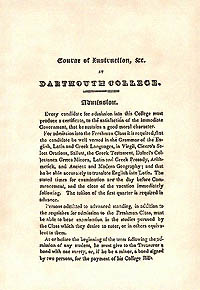
|
|
Levi Spaulding
Accounts of his 1814 Vision (Home Missionary I-IV, 1828-31) "The Spirit of Missions" "The Marble Monument" |
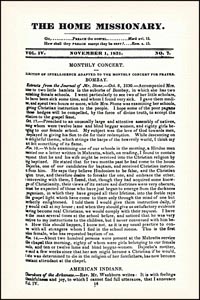
|
|
VOL. I. AUGUST 1, 1828. NO. 4. [p. 69]
THE SPIRIT OF MISSIONS.
I well recollect the morning -- I never can forget it, when, having been oppressed with the load of his guilt for many days, his countenance cast down, and his flesh wasted by the aŁony of his spirit, he invited me to take a solitary walk for the purpose of conversation. We wandered the distance of a mile, till we reached the bank of Connecticut river. He was agitated beyond expression. He knew that he was a sinner. He was convinced that it would be right in God to cast him off for ever; and yet his proud spirit would not submit to be saved by Christ. I invited him to kneel down with me and pray. After a pause, which indicated the conflict in his own bosom, he replied, "I will, if you will lead." I remarked, that I could pray for him with all my heart; but it appeared to me, that God was waiting for him to pray for himself. He hesitated a moment, and then dropped upon his knees, and prayed for the first time in his life. He ever after regarded that, as the place of his conversion.... (under construction) Note 1: According to Ralph Nading Hill's 1964 College on the Hill, Levi Spaulding was one of ninety students who participated in a revival centered at Dartmouth College, during 1814-15. Spaulding's Christian conversion vision reportedly came while he praying in a grove of trees near the bank of the Connecticut River. During that experience he looked up to see a blaze of light and knew thus he was saved from his sins (p. 205). In their 2008 JWHA paper, entitled, "Source of the Book of Mormon: Hill Cumorah or Dartmouth College?", Ron Dawbarn and Margie Miller describe Levi Spaulding's vision thusly: "[Levi, while he was] a student at Dartmouth also reported that he had felt remorse and concern over the fate of his immortal soul and retired to the woods to pray. There he saw a light brighter than the noon day sun and was assured of his forgiveness. He reported this on campus and [Eleazar] Wheelock wrote to his sister that it resulted in one of the greatest revival experiences at the school." Note 2: Levi Spaulding's vision was similar to that reported by the early LDS Apostle, Phinehas Young in 1858, when he said: "I was at a prayer meeting... the congregation were mostly praying for sanctification; I felt like one alone, for I could pray for nothing but to become holy, and I had got in one corner, as much alone as possible, when all of a sudden I saw a body of light above the brightness of the sun descending towards me; in a moment it filled me with joy unutterable: every part of my system was perfectly light and perfectly happy. I soon arose and spake of the things of the kingdom of God, as I had never spake before. I then felt satisfied that the Lord had heard my prayer and my sins were forgiven." Note 3: In 1816 the Rev. Elias Smith gave a similar account of his own conversion vision: "... I went into the woods one morning... I fell... [and] while in this situation, a light appeared to shine from heaven, not only into my head, but into my heart. This was something very strange to me, and what I never experienced before. My mind seemed to rise in that light to the throne of God and the Lamb, and while thus gloriously led, what appeared to my understanding was expressed in in Rev. xiv. i... The Lamb once slain appeared to my understanding, and while viewing him, I felt such love to him as I never felt to any thing earthly. My mind was calm and at peace with God through the Lamb of God, that taketh away the sin of the world. It is not possible for me to tell how long I remained in that situation..." Note 4: The Rev. Alexander Campbell (who claimed that his early associate, Sidney Rigdon, was a great advocate of Elias Smith style religious experience), mentioned in 1824, a revival among "Presbyterians, Methodists, and Baptists" in the state of New York," in which one "man was regenerated when asleep, by a vision of the night. That man heard a voice in the woods, saying,'Thy sins be forgiven thee.'" Campbell reported that another man "saw his Saviour descending to the tops of the trees at noon day." ("Address... No. IV," The Christian Baptist, Vol. I, No. 8, March 1, 1824, pg. 50). The Rev. Joshua Bradley reported in late 1824, "About 1000 in this region, since March or February last [1824], are rejoicing in a good hope through Christ." In Palmyra, a town about 30 miles North East of this, God has triumphed gloriously. About 200, as I am informed, are sharers in this great and precious work." About a year later, Rev. Joshua Bradley became a successor to Elder Sidney Rigdon, in the pastorate of the Pittsbutgh First Baptist Church. |
|
Richard K. Behrens
“Dreams, Visions...” (JWHA Journal XXVII, 2007) |
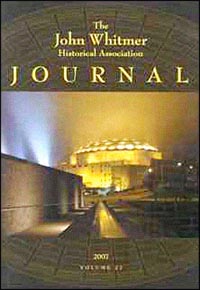
|
All rights reserved. Only "fair use" excerpts presented here)
|
[ 170 ]
[ 171 ] Joseph Smith Sr., along with his parents and his siblings, came from eastern Massachusetts by way of southern New Hampshire. [ 172 ] Hyrum, [10] after the principal characters in the masonic myth, Hiram king of Tyre and Hiram Abiff his principal architect, who according to the myth built Solomon's temple. Although Joseph's brother John, brother-in-law John C. Waller, and other relatives were accepted into the Randolph lodge, Joseph appears to have been rejected in 1801. [11] This rejection, however, might have been that of the other Joseph Smith, leaving the source of Hyrum's name in question. [ 173 ]
[ 174 ] narrow definition of the elect of God could tolerate neither heresy. In 1803 Jesse was clearly in the Universalist camp, [25] Lucy was a still a bit Calvinist, and Joseph Sr. appears to be undecided. Joseph's willingness to attend Methodist meetings with Lucy suggests that they were both heading in that direction. [26] As Universalism began to fade in the region and Calvinist rigidity was on the rise, the Smith family began seeking for some satisfying alternative. The religious tension would begin to come to a climax in 1810 when control of the board of trustees of Dartmouth College shifted from a narrow Arminian to a narrow Calvinist majority. [27] Soon openly engaged disputation evolved into vehemently contested revivals. In the midst of this religious malaise in December 1805 Joseph Jr. was born on the Solomon Mack farm, which straddled the boundary between Royalton and Sharon, Vermont. There must have been some concern before Joseph's birth since Joseph Sr. made a twenty-four-mile round-trip to fetch Dr. Joseph Adams Denison from Bethel, Vermont, who was the best known baby doctor in the region. [28] Denison had been trained by his cousin Joseph Adams Gallup who had been the first graduate of the new Dartmouth Medical School, founded in 1796 by Nathan Smith. [29] [ 175 ]
[ 176 ] the notion of arrival by ship originally suggested by John Smith in his 1780 lecture on the origin of native-American Aborigines. Spaulding's Manuscript Found was widely discussed among his family, most likely including his nephew James Spaulding [41] who was attending the Dartmouth Medical School and his second cousin Levi Spaulding [42] who was attending Dartmouth College at the time. [ 177 ]
[ 178 ] and that the great millennial day was at hand. [60] Levi Spaulding, one of ninety Dartmouth students who participated in this revival, had an epiphany in which while praying in a grove of trees he looked up to see a flash of light and knew he was saved. [61] At about this time Elias Boudinot's resurrected Indian spiritual advisor is also introduced to guide a devout Indian seeking more knowledge of the Great Spirit. [62] [ 179 ] (text deleted due to copyright restrictions) [ 180 ] resolving the doctrinal and Indian-origin issues that were being so heatedly discussed in the community discourse. [ 181 ] Therefore it can be argued that Joseph Jr.'s first vision, Book of Mormon, and later doctrine all seem to follow logically from the family dynamics of his childhood. Since there are few if any elements of Joseph Sr.'s dreams or Joseph Jr.'s later visions that were not discussed in at least rudimentary form at Dartmouth before 1817, it appears that the Dartmouth community discourse and the Smith family discourse have become deeply entwined. The resurrected Indian, who appeared in a dream to instruct a praying Indian on where to find a better understanding of the Great Spirit, entered the Dartmouth community discourse in 1816 by way of Elias Boudinot's A Star in the West and provided another interesting parallel, as did Solomon Spaulding's use of ships in Manuscript Found. [ 182 ]
[ 183 ]
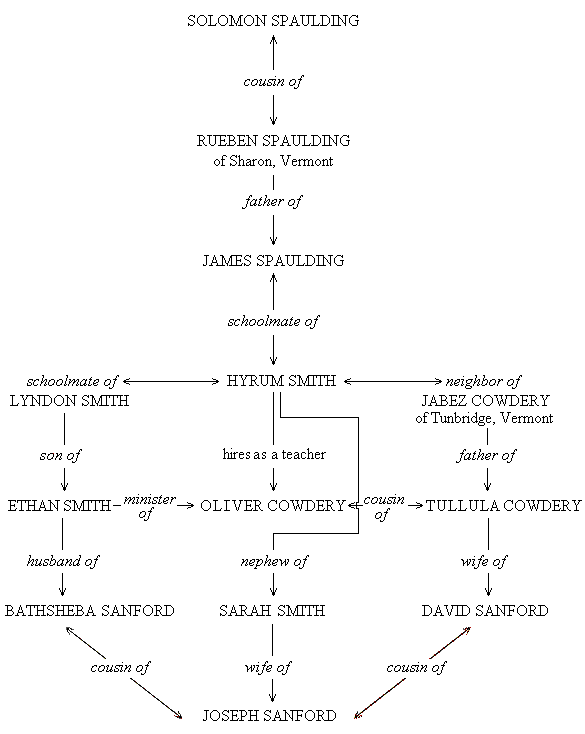
|
|
Dawbarn & Miller
“Source of the Book of Mormon: Hill Cumorah or Dartmouth College?” (Unpublished Paper, Restoration Studies Symposium; John Whitmer Historical Association Annual Meeting, April 2008) |
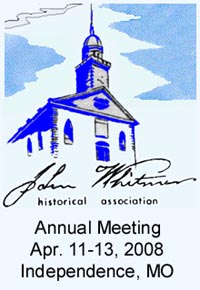
|
All rights reserved. Only "fair use" excerpts presented here)
|
(view entire pre-publication text, here)
|
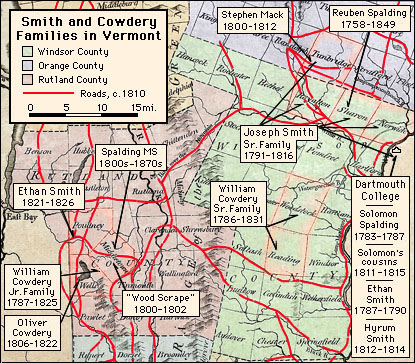
(under construction) |
return to top of page
Special Collections Index | New Spalding Library | Old Spalding Library
"Home" | Bookshelf | Mormon Classics | Newspapers | History Vault
last revised: March 6, 2008